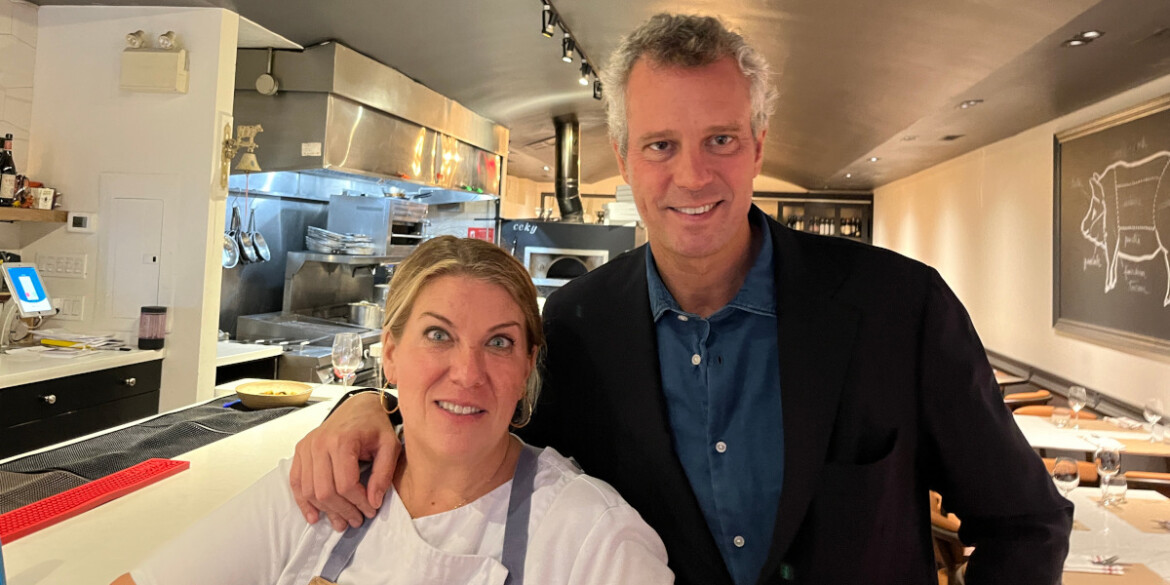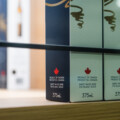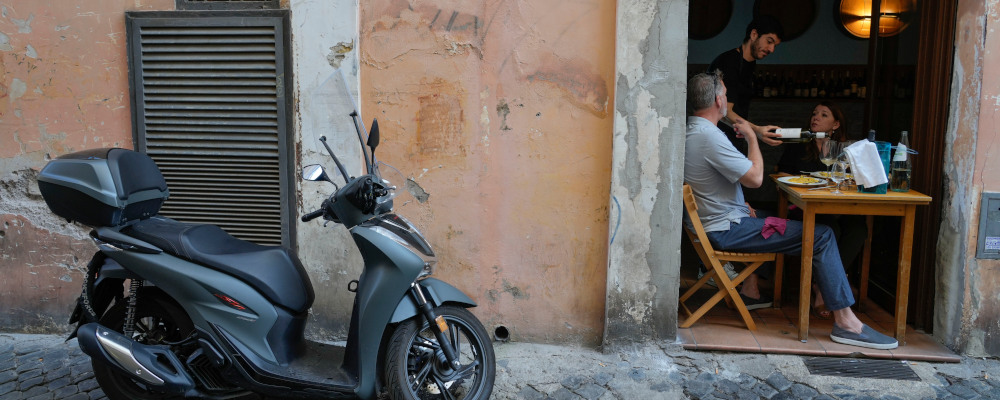I’m afraid I didn’t make it to the de-alcoholized wine tasting. I meant to. I thought I would have time after I first attended a regular wine tasting around the corner. I would have a couple of mouthfuls of half a dozen wines, spit them into a bucket, make some notes, and then carry on to the next. People make plans and God laughs.
People laugh, too. That first tasting turned out to be a lunch. A second lunch for me, but hey, I’m a pro, and when Chef Alida Solomon at Toronto’s Tutti Matti is cooking, I’m eating. Also when Alberto Moretti Cuseri is pouring, I am tasting, and I am likely not spitting. At least not after I have scribbled a few sober notes and the food begins to arrive.
Segnor Moretti Cuseri played host to me and a small group of sommeliers and wine media at a tasting arranged by his Ontario importer, Noble Estates. He is the third generation of his family to work at Tenuta Sette Ponti; his nephew is training as an oenologist and is the fourth. Sette Ponti means seven bridges, which is the number of them that span the Arno River between the property and area just west of Arezzo and Florence.

The Moretti Cuseri acquired Sette Ponti from the heirs of Prince Amadeo, Third Duke of Aosta in the 1950s. The Duke was a member of Turin’s House of Savoy, who were once Italy’s royal family. The Duke planted vines, but he was more interested in his twin passions of aviation and Africa. He served as the viceroy of Ethiopia when it was briefly an Italian colony. He died of malaria at the age of 43 as a prisoner of war in a British internment camp in Kenya in 1942.
While they enjoyed their once-royal estate for most of the latter half of the twentieth century, the Moretti Cuseri family focused the lion’s share of their attention on a successful fashion business. They turned their attention to serious winemaking at Sette Ponti in the 90s. They also began acquiring a handful of wine-making properties elsewhere in Tuscany and in Sicily. Alberto Moretti Cuseri serves as the export director for the family’s wineries and wines.
Over a lunch of ribollita soup, burrata with roasted pears and housemade pizza bread, and stewed wild boar on crostini, Moretti Cuseri poured three vintages of two wines: Oreno, which comes from Sette Ponti, and Orma, which comes from Bolgheri, in the Maremma near the Tuscan Coast of the Tyrrhenian Sea.
Orma means footprint, which may or may not allude to the Moretti Cuseris’ success in the shoe business, but also definitely, as Alberto Moretti Cuseri explained, is meant as a declaration of the family’s intent of making their mark in the prestigious Bolgheri DOC. The family established their winery at Orma in 2004 on a property situated in between the renowned estates of Ornellaia and Santa Guida, which famously makes Sassacaia. They wished to make a wine as prestigious as those of their neighbours.
The move to Bolgheri was not a departure. Alberto’s father began making a “Super Tuscan” wine at Sette Ponti from a blend of Merlot (50 percent), Cabernet Sauvignon (40 percent), and Petit Verdot (10 percent) in the late 1990s: Oreno. If Oreno’s success was inspired by the success of the Frescobaldi (by way of Antinori) family’s Ornellaia, and the Rochetta family’s Sassacaia, then it only makes sense that the Moretti Cuseris’ would also come west to Bolgheri. As a point of comparison, Orma is made from the same 50:40 of Merlot to Cabernet Sauvignon blend, although the missing 10 percent is not rounded out by Petit Verdot, but rather Cabernet Franc. It’s made by the same oenological team in the same way, and really does make for an interesting tasting when lined up across from one another.
We began with Orma from the Bolgheri DOC. Two glasses stood in front of us: the 2020 (about $100 a bottle) and the 2016 (about $150 a bottle). Both held the profile of a classic Super Tuscan. At first the recognition of the Bordeaux grapes, with blackberry and cassis notes, then an indication that the wines were neither Atlantic nor Pacific, but Mediterranean, with notes of garrigue, or in Italian, macchia.
The 2020 was silky, but young and tight. It gave intimations of future greatness. The 2016 Orma was revelatory, and exceptionally vibrant and alive. Black fruit and violets, lively acidity. Still very youthful, but also clear and clean.
Next came the Orma 2010 (about $180 a bottle), which at thirteen years of age showed little sign of it—at least it would have if the younger wines weren’t there to compare. It showed a tension between black and blue fruit and a red pepper jelly note. Alberto Moretti Cuseri had explained that the clay soils of the Irma property were high in iron; was there some of it on the glass, or was that just the power of suggestion? In any event, it drank very well.

Moving from the coast, up into the hills around the Arno River, we next turned our attention to the Sette Ponte estate and its Super Tuscan, Oreno. Again we began by comparing the most recent vintage available, the Oreno 2021 (about $100 a bottle) to the 2016 (about $150 a bottle). And again, the effect was rather similar: the 2016 seemed confoundingly younger somehow.
In the 2021dark cherry and black fruit notes simmered quietly in an inky interplay. A calming wine, that was a bit closed and shy. The 2016 on the other hand showed a cassis and black fruit energy over velvet tannins.
Then the last wine: the 2010 Oreno, from a magnum (about $400 for 1.5 litres), it had been decanted earlier. Even with the exposure to air it was slowly rousing and showing like a wine much younger than thirteen years. My note is scribbled: perfect Claret but with garrigue. If I had tasted it blind, I would have guessed Bordeaux; if I was on my game the blackberry notes might have put me onto Merlot, and possibly the Right Bank. But then, there would be the finish that’s herbal with the suggestion of mint, placing the wine firmly into the spine of Italy. Super Tuscan indeed.
Antonio Moretti Cuseri’s late twentieth-century gamble with Merlot and Cabernet Sauvignon has paid off and the dividends are delicious. All the wines we tasted only improved when sipped between mouthfuls of food, the purpose for which, after all, they were made. It’s become accepted practice in some wine circles to downplay the so-called “international grapes” in favour of those called “indigenous”. But great wines never really go out of style, as the price tags on the Sette Ponti wines attest. Nor does pleasure, which should be taken when and where it’s found.
Recommended for You

Matthew Grills: Joey Chestnut is America

Malcolm Jolley: The comfort of familiar favourites—or the fun of finding new wines?

Malcolm Jolley: An ‘Elbows Up’ wine project everyone can get behind

Malcolm Jolley: Need some summer wines? Look no further than the food-friendly, low-sugar sippers of the sunny Southern Rhône




